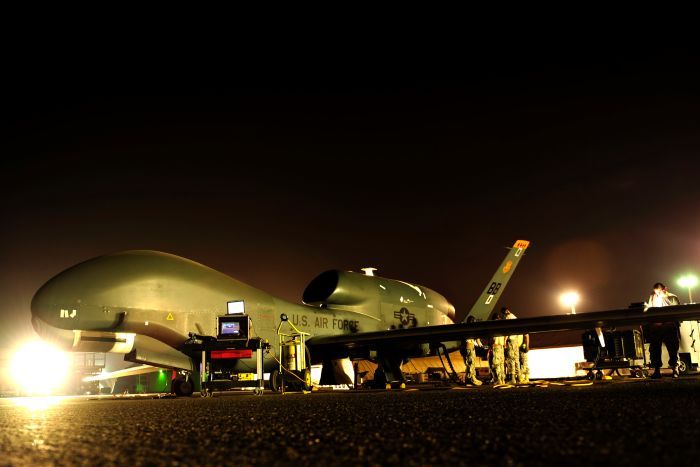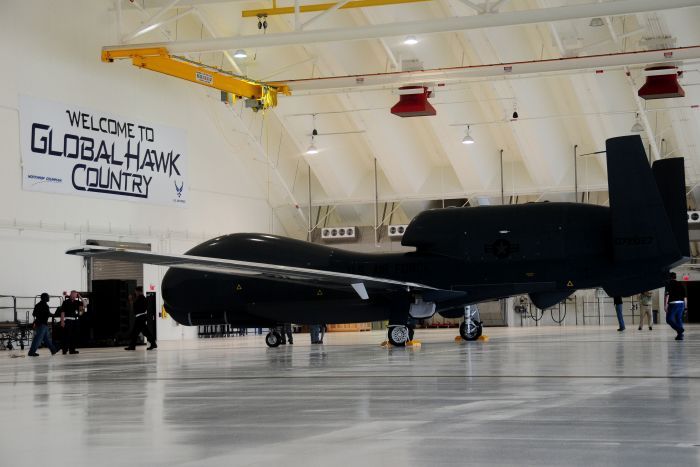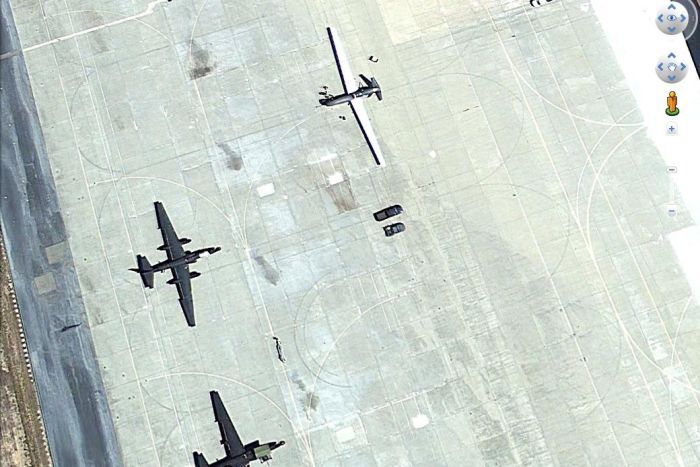
Revealed: US flew spy drone missions from Australia
Foreign Correspondent online editor Mark Corcoran
The United States flew highly classified Global Hawk spy drone missions from the Royal Australian Air Force base at Edinburgh in South Australia from late 2001 until at least 2006.
The operations were detected by a group of Adelaide aviation historians who had a member monitoring aircraft radio frequencies 20 hours a day.
With a wingspan greater than a 737 airliner and a $200 million price tag, the RQ-4 Global Hawk is the biggest, most expensive unmanned aerial vehicle to ever take to the skies.
The spy drone is the jewel in the crown of America's global electronic intelligence-gathering network. Global Hawk operations are cloaked in secrecy, and the US Air Force likes to keep it that way.
But perhaps the Pentagon severely underestimated the vigilance of Adelaide aviation historians the West Beach Aviation Group (WBAG).
[The Global Hawks] usually approached and departed at night, although there were a few exceptions – and then they were photographed by the group.
West Beach Aviation Group spokesman Paul Daw
WBAG members have told ABC's Foreign Correspondent that they monitored the flights until Australian defence security officials paid them a visit and demanded they not publish material revealing the presence of the Global Hawks.
"[The Global Hawks] usually approached and departed at night, although there were a few exceptions – and then they were photographed by the group," WBAG spokesman Paul Daw said.
"But there were sensitivities. A photographer (from the group) was visited unannounced by Australian military security and questioned for putting movements onto an international web site.
"They claimed he showed vulnerabilities of the base."
WBAG group members say they take national security seriously, but argue there are no restrictions on photographing or monitoring US aircraft in Australian skies.
Details of Global Hawk movements were published in the group's limited-circulation newsletter.
Still, the US government was determined to keep a lid on the spy drone missions.
Editor's note: After publication of this story, Foreign Correspondent was contacted by group members who now claim Defence security officials demanded they refrain from publishing details of Australian military aircraft, not US Global Hawks, as expressed in an earlier interview.
Unusual chatter provides drone giveaway
 Photo: A Global Hawk spy drone is prepared for a night mission at an undisclosed location in the Middle East. (Supplied: US Air Force)
Photo: A Global Hawk spy drone is prepared for a night mission at an undisclosed location in the Middle East. (Supplied: US Air Force)
Quick facts: RQ-4 Global Hawk
Role: Intelligence, surveillance and reconnaissance
Built by: Northrop Grumman
Power plant: Rolls Royce-North American F137-RR-100 turbofan engine
Wingspan: 39.8 metres
Length: 14.5 metres
Height: 4.7 metres
Maximum takeoff weight: 14.6 tonnes
Payload (cameras/electronic eavesdropping equipment): 1.36 tonnes
Speed: 570 km per hour
Official range: 16,100 kilometres
Official ceiling: 18,288 metres
Armament: None
Crew (remote): Two pilots and a sensor operator.
Source: US Air Force
Foreign Correspondent understands that in 2004, the then-Australian defence minister, South Australian Liberal senator Robert Hill, notified the Americans of his intention to announce the flights to the Australian public.
But the US Air Force vigorously opposed the defence minister's planned disclosure, demanding all Global Hawk operations remain classified.
Mr Hill, who has since left federal Parliament, did not respond to requests to comment on this story.
South Australia's then Labor premier, Mike Rann, who at the time was lobbying for a greater Defence presence in his state, was not told of the sensitive US military flights.
Global Hawk's only official visit to Australia was in April 2001, touching down at RAAF Edinburgh amid a blaze of publicity as it completed a record-breaking 14,000-kilometre flight across the Pacific from California.
But after the terrorist attacks of September 2001, Global Hawk disappeared off the public radar.
As Washington ramped up its declared war on terror, the spy drones were dispatched worldwide. They were seen flying from bases in California and the United Arab Emirates.
But the covert reach of Global Hawk went much further.
Mr Daw says the spy drones began quietly slipping into South Australia two months later, in November 2001.
"The reason we knew a Global Hawk was coming is we'd see a C141 Starlifter arrive up to a week earlier and unload a shipping container or two. These were for command and control - to control the approach of Global Hawk," he said.
Mr Daw says the group's 30 volunteers include a retired airline captain, commercial pilots, photographers and an air traffic controller, so they knew exactly what to expect.
To get a heads-up on approaching aircraft, Paul Daw says, "one of our guys monitors aircraft radio frequencies 20 hours a day".
He explains that to get a heads-up on approaching aircraft, "one of our guys monitors aircraft radio frequencies 20 hours a day".
Mr Daw says unusual radio chatter on local air traffic control frequencies heralded the approach of a spy drone.
"They used a strange call sign. The Global Hawk would line up to land from 200 nautical miles out over Port Augusta," he said.
Global Hawk's American manufacturer, Northrop Grumman, provided civilian ground crews to service the drones at the RAAF base.
Why fly from Australia?
The Australian Defence Department now confirms US Global Hawks visited Australia, but plays down the significance of the missions.
In an email response to our questions a Defence spokesperson said: "Global Hawk visits to Australia are rare but have previously occurred, principally to RAAF Base Edinburgh near Adelaide. Global Hawk visits to Australia since the 2001 trial have been for short replenishment purposes."
Adelaide was initially a transit stop for Global Hawks en route from the west coast of the US to the Al Dhafra air base in the United Arab Emirates, but a number of aviation industry insiders claim that is not the whole story.
Mr Daw speculates "the flights were believed to be surveillance missions of Afghanistan".
Later the drone stopovers were extended.
I believe RAAF Edinburgh was chosen because it is close to but outside a major city, had hangars that could conceal the Global Hawk and back then, it was a quiet base.
aviation watcher Paul Daw
"Sometimes a Global Hawk would go out [from RAAF Edinburgh] on two or three flights. The aircraft would climb to 60,000 feet," Mr Daw said.
"Who knows where they went ... they had enough fuel for 30 to 35 hours, and they'd return."
The aviation enthusiasts say they spotted 10 missions to Adelaide. "But they are just the ones we know about", concedes one member.
While the Australian public and the South Australian Government were left in the dark, there were no restrictions on the international media.
In February 2006, an American journalist from industry publication Aviation Week and Space Technology was given access to report on a single Global Hawk reconnaissance mission from RAAF Edinburgh to southern Japan and back again.
Officially, this was a demonstration flight for the Japanese, who were keen to acquire Global Hawk.
The timing of the mission was intriguing, launched just one week after North Korea had conducted a series of failed missile tests.
At the time, US intelligence was intensely focused on determining North Korea's offensive military capabilities.
Were the US Global Hawks targeting countries in our region? And why did the drones need to fly specifically to Edinburgh for "replenishment", requiring such a huge detour from the international hotspots they targeted?
The Australian Defence Department refuses to comment.
Mr Daw thinks location was a key factor.
"I believe RAAF Edinburgh was chosen because it is close to but outside a major city, had hangars that could conceal the Global Hawk and back then, it was a quiet base," he said.
Almost every day one of the US Air Force Global Hawks based on the island of Guam can be found flying off the North Korean coastline.
intelligence analyst Matthew Aid
American author Matthew M Aid, an analyst specialising in US intelligence operations in the post-9/11 world, agrees.
He says Global Hawk operations in the Asia-Pacific region have been based out of Andersen Air Force Base on the US territory of Guam – but only since 2010.
He says concealing the presence of the spy drones has always been a priority (see image below).
"The problem with Andersen was the lack of hangars. US intelligence doesn't like the drones parked out in the open ... they’ve got to be in hangars and these weren't completed until mid to late 2010 to avoid Russian and Chinese satellite detection," he said.
"Almost every day one of the US Air Force Global Hawks based on the island of Guam can be found flying off the North Korean coastline taking pictures of targets deep inside the country that are more detailed than those coming from satellites.
"They fly at 60,000 feet, 75 miles off the North Korean coastline, taking grainy shots taken from a 45-degree angle."
Mr Aid says that before 2010 "a forward operation location at Edinburgh would have been a perfect place".
Obsessive secrecy
 Photo: A Global Hawk spy drone inside a hangar at Andersen Air Force Base on Guam, safe from the prying eyes of Russian and Chinese satellites. (Supplied: US Air Force)
Photo: A Global Hawk spy drone inside a hangar at Andersen Air Force Base on Guam, safe from the prying eyes of Russian and Chinese satellites. (Supplied: US Air Force)
Mr Aid says Global Hawk operations are cloaked in obsessive secrecy.
"The US Air Force, for some bizarre reason, classifies everything to do with drones as 'codeword' top secret – that means above top secret," he said.
While the US wanted to avoid disclosure of the flights, it appears Global Hawk's targets already knew when the spy drones were coming.
"Global Hawk is so big – with sharp angles, with no stealth at all – even a third-rate nation can pick up Global Hawk flights using airport radar," Mr Aid said.
Global Hawk is so big – with sharp angles, with no stealth at all – even a third-rate nation can pick up Global Hawk flights using airport radar.
intelligence analyst Matthew Aid
He says that between 2002 and 2005, Iranian diplomats routinely lodged diplomatic protests over US spy drones "flying daily signals intelligence and imagery collection missions along Iran's borders with Iraq and Afghanistan and along Iran's Persian Gulf coastline".
When Global Hawk first visited Australia on its public-relations flight in April 2001, the drone was still in its development phase and there were concerns over its reliability, Mr Aid says.
He says after September 11 "the Air Force didn't really have time to flight-test the Global Hawk, they had to get it operational ASAP".
"They required hundreds of man hours before every flight - 45 men and women working on each one non-stop to keep it mission capable. The sensors are incredibly complex," he said.
Mr Aid says maintenance and refuelling stops at Edinburgh made sense on the completion of missions or when the drones were in transit from the US to the Middle East and other locations.
Adelaide was also considered friendly territory.
Mr Aid says the US and Australia share much of the highly sensitive signals intelligence gathered by assets such as Global Hawk.
"Australia is a member of the so-called Five Eyes intelligence club that also includes the US, the United Kingdom, Canada and New Zealand," he said.
At the time Australia was considering buying Global Hawk, the missions could have given RAAF officers a chance for a closer inspection.
Mr Daw says the Adelaide group last spotted a Global Hawk in 2006. Other aviation industry sources claim the spy drones continued to fly to Australia beyond that date and that RAAF Edinburgh remains on the approved list of landing sites.
Global Hawk sightings have since been limited to a full-size promotional mock-up wheeled out at the Avalon Air Show near Melbourne.
Plausible deniability?
 Photo: A Global Hawk drone and two U2 manned spy planes on the tarmac at Beale Air Force Base in California. (Supplied: Google Earth)
Photo: A Global Hawk drone and two U2 manned spy planes on the tarmac at Beale Air Force Base in California. (Supplied: Google Earth)
The US Air Force now operates a fleet of 23 Global Hawks from a headquarters at Beale Air Base in California and a facility at Grand Forks, North Dakota.
The spy drones maintain global surveillance coverage by rotating through three forward operating bases: Al Dhafra in the UAE, Sigonella US Naval Air Station on Sicily and Andersen Air Force Base on Guam.
Now Russian and Chinese satellites have been joined by commercial competitors in photographing the elusive drones on the ground.
The advantage of Global Hawk is that it is designed for over-flight in 'denied territory' at high altitude. If it gets shot down, you don't lose a pilot – and that allows public deniability for the State Department.
intelligence analyst Matthew Aid
Google Earth captured this image of a Global Hawk (also above) on the tarmac at Beale. The drone is parked next to two slender-winged U2 aircraft, the 1950s-era piloted spy plane that Global Hawks were intended to replace.
Mr Aid says despite the capability to fly non-stop missions around the globe, the $200 million Global Hawk still has many critics in the US Air Force: a so-called 'white-scarf brigade' of pilots who fear drones will put them out of a job.
"They complain they can't get the same capability as the U2, which has the advantage of bigger, better cameras, so senior people in the USAF advocate bringing back the U2," he said.
"The Global Hawk without a driver is nowhere near as sexy and has severe limitations."
Facing major budget cuts, the US Air Force's top general considered mothballing some Global Hawks and cancelling future orders because the drone costs too much to fly.
Related reading
Drone journalism takes offAs the media starts to deploy small toy-like drones to cover stories, what ethical and safety issues are arising?
The kill chain: Australia's drone war
Find out how Australia deploys a fleet of Israeli-owned Heron drones to support its troops in Afghanistan.
"The reality is that the Global Hawk system has proven not to be less expensive to operate than the U2," General Norton Schwartz said in January.
Global Hawk got a temporary reprieve in July when Congress blocked plans to reduce the size of the fleet.
The 'white-scarf brigade' may still prefer to get behind the controls of the venerable U2 but Mr Aid says America's diplomats have become big fans of Global Hawk.
"The State Department likes Global Hawk because there is a certain degree of deniability. The advantage of Global Hawk is that it is designed for over-flight in 'denied territory' at high altitude," he said.
"If it gets shot down, you don't lose a pilot – and that allows public deniability for the State Department."
If the US military was seeking plausible deniability, then perhaps the Global Hawks should have stayed well away from Adelaide and the city's vigilant aviation enthusiasts.
Rise of the Machines - Drones
Tomorrow night on ABC1, Foreign Correspondent sounds the alarm on the swarms of private and government drones gathering in American skies and surely bound for the rest of the world.
Some of the drones have live streaming cameras and the ability to carry other payloads, and tens of thousands of them are expected to take to the sky.
But who's at the controls? Potentially anybody.
And in Part II of this report tomorrow: Drone dogfight - how the Australian Defence Force is quietly planning to buy seven huge surveillance drones that could cost up to $3 billion.
Additional credit: Foreign Correspondent executive producer Steve Taylor.
Topics: security-intelligence, defence-and-national-security, unrest-conflict-and-war, edinburgh-5111, sa, united-states, australia
VIEW VIDEOS
http://www.abc.net.au/news/2012-09-03/revealed-us-flew-drone-missions-from-australia/4236306
